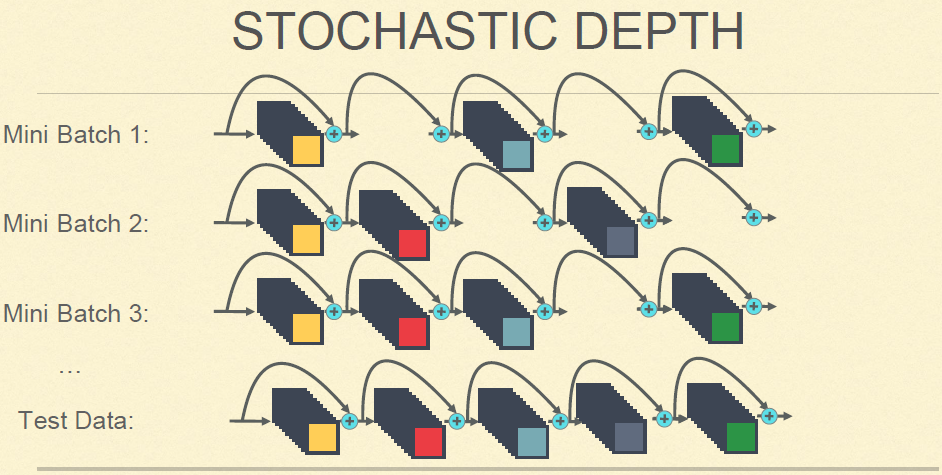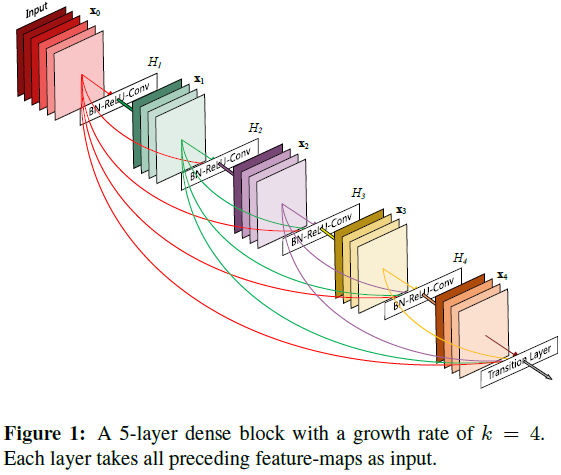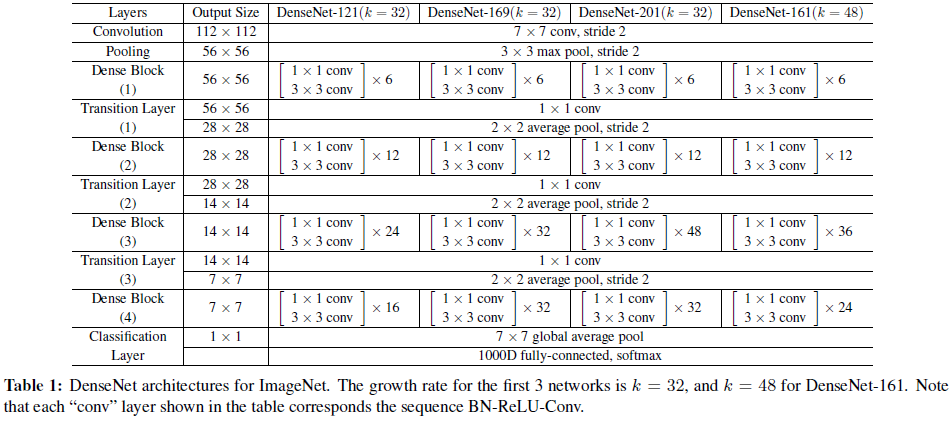Paper | Densely Connected Convolutional Networks
发表在2017 CVPR。
摘要
Recent work has shown that convolutional networks can be substantially deeper, more accurate, and efficient to train if they contain shorter connections between layers close to the input and those close to the output. In this paper, we embrace this observation and introduce the Dense Convolutional Network (DenseNet), which connects each layer to every other layer in a feed-forward fashion. Whereas traditional convolutional networks with L layers have L connections—one between each layer and its subsequent layer—our network has \(\frac{L(L+1)}{2}\) direct connections. For each layer, the feature-maps of all preceding layers are used as inputs, and its own feature-maps are used as inputs into all subsequent layers. DenseNets have several compelling advantages: they alleviate the vanishing-gradient problem, strengthen feature propagation, encourage feature reuse, and substantially reduce the number of parameters. We evaluate our proposed architecture on four highly competitive object recognition benchmark tasks (CIFAR-10, CIFAR-100, SVHN, and ImageNet). DenseNets obtain significant improvements over the state-of-the-art on most of them, whilst requiring less computation to achieve high performance. Code and pre-trained models are available at https://github.com/liuzhuang13/DenseNet.
结论
We proposed a new convolutional network architecture, which we refer to as Dense Convolutional Network (DenseNet). It introduces direct connections between any two layers with the same feature-map size. We showed that DenseNets scale naturally to hundreds of layers, while exhibiting no optimization difficulties. In our experiments, DenseNets tend to yield consistent improvement in accuracy with growing number of parameters, without any signs of performance degradation or overfitting. Under multiple settings, it achieved state-of-the-art results across several highly competitive datasets. Moreover, DenseNets require substantially fewer parameters and less computation to achieve state-of-the-art performances. Because we adopted hyperparameter settings optimized for residual networks in our study, we believe that further gains in accuracy of DenseNets may be obtained by more detailed tuning of hyperparameters and learning rate schedules. Whilst following a simple connectivity rule, DenseNets naturally integrate the properties of identity mappings, deep supervision, and diversified depth. They allow feature reuse throughout the networks and can consequently learn more compact and, according to our experiments, more accurate models. Because of their compact internal representations and reduced feature redundancy, DenseNets may be good feature extractors for various computer vision tasks that build on convolutional features, e.g., [4, 5]. We plan to study such feature transfer with DenseNets in future work.
要点和优点
稠密连接:每一层的输出特征图,都将作为其后所有层的输入。
网络可以深得多,优化难度却很低。
网络参数量更少,所需计算量大幅下降,性能却显著提升。
当提高参数量时,网络泛化能力也很好,不容易过拟合。
黄高老师190919在北航的报告听后感
一年前第一次看这篇文章时,感觉DenseNet无非是ResNet的一种极致扩展。但黄高老师给我提供了一种全新的思考。
我们首先看一个随机深度网络:如下图,在训练时,若干层会随机消失(由恒等变换或短路代替),在测试时再全部用起来。

这个网络的泛化能力得到了显著提升。原因:这种类似于dropout形式的训练,迫使网络不会过于依赖于某一层。因为传统CNN是级联结构,黄老师认为,如果某一层出现问题,那么错误就会被逐级放大。因此这种随机深度+短路的形式,可以提升网络的泛化能力。
总之,我们应该看到以下两个矛盾:

那么,我们应该怎么取得权衡呢?
首先,我们应该保证网络的泛化能力,即引入适当的冗余。冗余不是臃肿,而是让网络不过度依赖某些参数或特征,从而具有一定的健壮性。短连接就是一个很好的方法,因为实验发现,大多数梯度传输都是通过短连接实现的。因此,黄老师就将此发挥到了极致:稠密连接。
其次,我们要尽量降低冗余。由于特征是稠密复用的,因此我们可以适当减少特征图数量,从而减少网络的整体参数量和计算量:我们大幅度减少每一层的特征图数量:


网络加深到121层(实验发现18层没有优势,因为特征图太少),参数量却低得多:

总之,如果我们将DenseNet理解为冗余与计算量的权衡,我们就对DenseNet有了更深层次的认知。
故事背景
尽管CNN已经发展了20多年,近期只有Highway Networks和ResNets突破了100层。
网络结构
Dense block

上图是一个示意图。注意,ResNet是将特征逐点求和,再输入下一层或输出,而这里DenseNet是将特征图通道拼接起来。同时注意,最后一层是过渡层(Transition Layer),也算在block内。
对于某个block内的第\(l\)个卷积层,其输入为\(l\)个输入的拼接。如果该block内一共有\(L\)层,那么一共就有\(l + (l-1) + \dots + 1 = (l + 1) \frac{l}{2}\)个连接。
DenseNet
我们看整体网络结构。在本文中,当通道拼接后,会依次执行BN、ReLU和\(3 \times 3\)的卷积。整体网络由多个block组成:

过渡层
还有一个问题。由于需要通道拼接,因此我们要保证特征图的尺寸相同。但显然这是很愚蠢的做法。为此我们有两点改进:
- 引入block的概念,每一个block内稠密连接,block之间的尺寸不保证相同。
- 为了完成block之间的过渡,作者引入了过渡层(transition layers),其包含BN、\(1 \times 1\)卷积以及\(2 \times 2\)的池化层。
在过渡层,我们让特征图数量减半(输出通道数等于输入通道数的一半)。这种设计以DenseNet-BC代替。
成长率
这种稠密连接的结构有一个反直觉的特点:其参数量(可以)非常小(批注:原因上一节我也提到了)。我们先看ResNet,它的参数量很大,原因是每一层的特征图都比较多也比较庞大。而对于DenseNet,每一层的特征图只限定为很小的数目,比如每层12张。作者称该超参数为成长率(growth rate)\(k\)。实验证明较小的成长率是足够的。
瓶颈层
尽管特征图数量\(k\)不大,但是拼接后的特征图数量还是太大了。为此,我们引入瓶颈层(bottleneck layers),即\(1 \times 1\)卷积层,在保证特征图尺寸不变的条件下,减小特征图数目。具体做法:在拼接后、BN+ReLU-\(3 \times 3\)Conv之前,加入BN+ReLU+\(1 \times 1\)Conv,即最终变成BN - ReLU - Conv (\(1\times 1\)) - BN - ReLU - Conv (\(3 \times 3\))。本文采用DenseNet-B表示这一结构,并通过实验证明其优势。
细节
DenseNet中一共有3个dense block,每一个block内的特征图尺寸分别是\(32 \times 32\)、\(16 \times 16\)和\(8 \times 8\)。
在最开始,\(3 \times 3\)的卷积作用于输入图像,得到16通道的特征图,再输入第一个dense block。
对于\(3 \times 3\)卷积,两侧分别插一个零,保证特征图尺寸不变。
在过渡层,\(1 \times 1\)卷积搭配\(2 \times 2\)平均池化,如上图。
一个全局平均池化和softmax分类器搭载在最后一层之上,得到分类结果。
作者尝试了40层+成长率12、100层+成长率24、250层+成长率24等。
在ImageNet上的实验,作者采用的网络配置如下:

实验
我们主要看这个图:

这表明:
稠密连接+瓶颈处理+过渡层压缩性能最佳。
与ResNet相比,DenseNet-BC不仅性能更好,参数量需求也更低。
DenseNet泛化能力更好。虽然训练误差比ResNet高,但是测试效果是几乎一致的(在相同epoch条件下,与ResNet-1001相比)。
Paper | Densely Connected Convolutional Networks的更多相关文章
- Densely Connected Convolutional Networks 论文阅读
毕设终于告一段落,传统方法的视觉做得我整个人都很奔溃,终于结束,可以看些搁置很久的一些论文了,嘤嘤嘤 Densely Connected Convolutional Networks 其实很早就出来了 ...
- Deep Learning 33:读论文“Densely Connected Convolutional Networks”-------DenseNet 简单理解
一.读前说明 1.论文"Densely Connected Convolutional Networks"是现在为止效果最好的CNN架构,比Resnet还好,有必要学习一下它为什么 ...
- 深度学习论文翻译解析(十五):Densely Connected Convolutional Networks
论文标题:Densely Connected Convolutional Networks 论文作者:Gao Huang Zhuang Liu Laurens van der Maaten Kili ...
- 【Network Architecture】Densely Connected Convolutional Networks 论文解析
目录 0. Paper link 1. Overview 2. DenseNet Architecture 2.1 Analogy to ResNet 2.2 Composite function 2 ...
- Densely Connected Convolutional Networks(緊密相連卷積網絡)
- Dense blocks where each layer is connected to every other layer in feedforward fashion(緊密塊是指每一個層與每 ...
- DenseNet——Densely Connected Convolutional Networks
1. 摘要 传统的 L 层神经网络只有 L 个连接,DenseNet 的结构则有 L(L+1)/2 个连接,每一层都和前面的所有层进行连接,所以称之为密集连接的网络. 针对每一层网络,其前面所有层的特 ...
- 【文献阅读】Densely Connected Convolutional Networks-best paper-CVPR-2017
Densely Connected Convolutional Networks,CVPR-2017-best paper之一(共两篇,另外一篇是apple关于GAN的paper),早在去年八月 De ...
- (转)ResNet, AlexNet, VGG, Inception: Understanding various architectures of Convolutional Networks
ResNet, AlexNet, VGG, Inception: Understanding various architectures of Convolutional Networks by KO ...
- VGGNet论文翻译-Very Deep Convolutional Networks for Large-Scale Image Recognition
Very Deep Convolutional Networks for Large-Scale Image Recognition Karen Simonyan[‡] & Andrew Zi ...
随机推荐
- 【AtCoder】AtCoder Grand Contest 040 解题报告
点此进入比赛 \(A\):><(点此看题面) 大致题意: 给你一个长度为\(n-1\).由\(<\)和\(>\)组成的的字符串,第\(i\)位的字符表示第\(i\)个数和第\( ...
- python 学习(day1)
初识python python的创始人为吉多*范罗苏姆(Guido van Rossum).1989年圣诞节期间,开发出来的脚本解释程序. python是⼀⻔什么样的语言 python 是一门解释型语 ...
- 前端优化,包括css,jss,img,cookie
前端优化,来自某懒观看麦子学院视频的笔记. 尽可能减少HTTP的请求数 使用CDN 添加Expirs头,或者Cache-control Gzip组件压缩文件内容 将CSS放在页面上方 将脚本放到页面下 ...
- 【洛谷5008】逛庭院(Tarjan,贪心)
[洛谷5008]逛庭院(Tarjan,贪心) 题面 洛谷 题解 如果图是一个\(DAG\),我们可以任意选择若干个不是入度为\(0\)的点,然后把它们按照拓扑序倒序删掉,不难证明这样一定是合法的. 现 ...
- 利用zabbix监控ogg进程(Windows平台下)
本文给大家介绍如何监控windows平台下的ogg程序.(注:所有操作都在administrator用户下面进行操作) 监控linux平台下的ogg程序请看:https://www.cnblogs.c ...
- win10 关闭 “在时间线中查看更多日期” 提示
在组策略中,禁用允许上传用户活动
- MySQL(8)---游标
Mysql(8)-游标 上一遍博客写了有关存储过程的语法知识 Mysql(7)---存储过程 游标或许你在工作中很少用到,但用不到不代表不去了解它,但你真正需要它来解决问题的时候,再花时间去学习很可能 ...
- JQuery的介绍及选择器
1.什么是JQuery. JavaScript开发的过程中,处理浏览器的兼容很复杂而且很耗时,于是一些封装了这些操作的库应运而生.这些库还会把一些常用的代码进行封装. 把一些常用到的方法写到一个单独的 ...
- Flask--请求扩展
目录 请求扩展 before_request after_request before_first_request teardown_request errorhandler template_glo ...
- H265之格式解析
头定义如下: 上一段码流: 前面 4个字节位00 00 00 01 为nul头,这个和H264是一样的. 下面两个字节为40 01 ====>二进制 0100 0000 0000 0001 F ...
